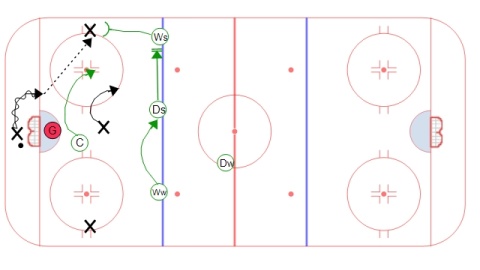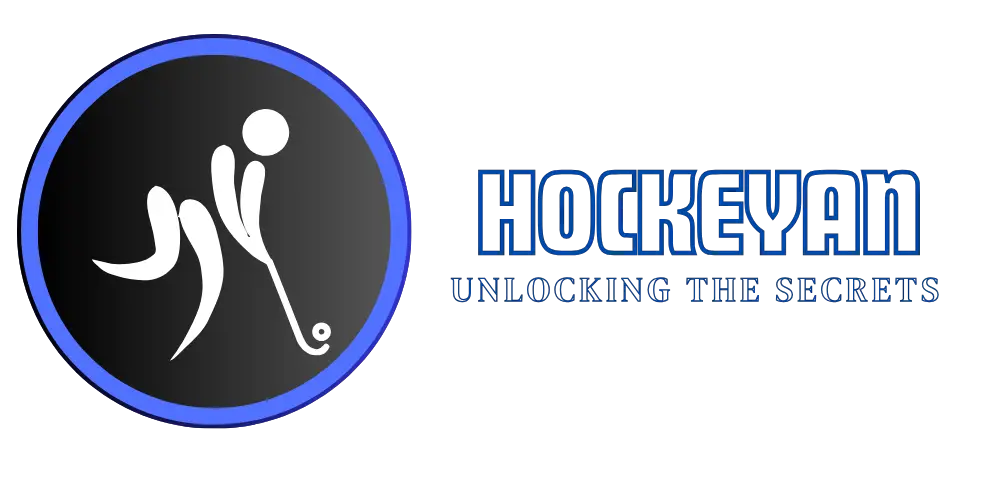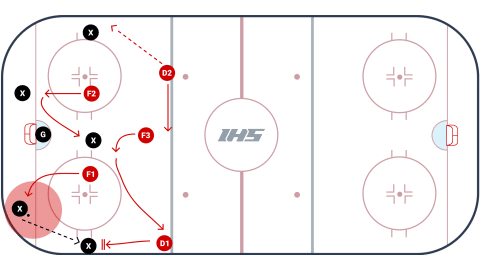Forecheck hockey is a crucial strategy in the game. It can turn defense into offense swiftly.
Understanding forecheck hockey helps in grasping team tactics better. In hockey, forechecking involves players putting pressure on opponents to regain puck control. It is a proactive approach, aiming to disrupt the opposing team’s play. Coaches often emphasize this tactic to create scoring opportunities and keep the puck in the offensive zone.
Knowing different forechecking systems can improve a player’s effectiveness on the ice. Whether you’re a player, coach, or fan, learning about forecheck hockey enhances your appreciation of the game’s strategic depth. Dive in to explore the techniques and importance of forechecking in hockey.
Introduction To Forecheck Hockey
Forecheck hockey is a key strategy in the game of ice hockey. It involves players applying pressure on the opposing team in their defensive zone. This strategy aims to regain puck control and create scoring opportunities. Understanding forecheck hockey is essential for both players and fans.
Origins Of Forecheck
Forechecking has been part of hockey since its early days. The strategy evolved as teams looked for ways to disrupt their opponents. Early hockey teams realized that aggressive play in the offensive zone could lead to turnovers. This discovery led to the development of different forechecking systems.
Importance In Modern Play
Forechecking remains crucial in today’s hockey. It helps teams maintain pressure and control the game. A good forecheck can disrupt the opponent’s breakout plays. This often leads to scoring chances. Coaches emphasize forechecking to keep the opposing team on their heels.
Modern hockey strategies often include various forechecking techniques. Teams may use a 1-2-2 or a 2-1-2 forecheck. These systems involve different player positions and responsibilities. The goal is always the same: regain puck control and create offensive opportunities. Forechecking also helps in tiring out the opponent, making it hard for them to mount an effective attack.

Credit: www.youtube.com
Types Of Forechecking Strategies
Forechecking is a crucial aspect of hockey that involves pressuring the opposing team in their defensive zone. There are various forechecking strategies that teams can use to gain control of the puck. Each strategy has its own formation and style, which can significantly impact the game’s outcome.
1-2-2 Formation
The 1-2-2 formation is a common forechecking strategy. It involves one forward applying pressure deep in the offensive zone. Two other forwards stay higher, covering passing lanes and intercepting any attempts to break out. Finally, the two defensemen stay back to guard against any rushes. This formation is often used to create turnovers and maintain control of the puck.
2-1-2 Formation
The 2-1-2 formation involves two forwards aggressively forechecking deep in the offensive zone. One forward stays in the middle to support the play and cover any loose pucks. Two defensemen hold the blue line, ready to pinch if needed. This strategy creates intense pressure and can quickly overwhelm the opposing team, forcing mistakes.
Aggressive Vs. Passive Styles
Forechecking strategies can be either aggressive or passive. In an aggressive style, players apply constant pressure and force the opponent to make quick decisions. This can lead to turnovers and scoring opportunities. Passive forechecking, on the other hand, focuses on positioning and waiting for the opponent to make a mistake. This style is more about patience and controlling the play rather than forcing it.
| Formation | Key Characteristics |
|---|---|
| 1-2-2 | One forward deep, two forwards high, two defensemen back. |
| 2-1-2 | Two forwards deep, one forward in the middle, two defensemen on the blue line. |
| Aggressive | Constant pressure, force quick decisions, create turnovers. |
| Passive | Positioning, patience, control the play, wait for mistakes. |
Key Skills For Effective Forechecking
Forechecking is a crucial part of hockey that involves pressuring the opponent in their defensive zone. Effective forechecking requires several key skills that players need to master. These skills can be broken down into skating and speed, stick handling, and positioning and awareness.
Skating And Speed
Skating and speed are fundamental for a successful forecheck. Players need to move quickly to close gaps and apply pressure. Strong acceleration helps reach the puck before the opponents. Quick direction changes are essential to stay with the play. Consistent speed can disrupt the opponent’s breakout attempts.
Stick Handling
Stick handling is another critical skill for forechecking. Players must control the puck under pressure. Good stick handling prevents turnovers and maintains possession. Effective stick handling allows players to make quick passes. This skill is important for creating scoring opportunities.
Positioning And Awareness
Positioning and awareness are vital for forechecking. Players must understand their role within the team’s system. Good positioning blocks passing lanes and forces turnovers. Awareness of teammates’ positions supports coordinated efforts. This skill helps in anticipating the opponent’s moves.
| Skill | Description |
|---|---|
| Skating and Speed | Quick movement and direction changes to apply pressure. |
| Stick Handling | Control of the puck to avoid turnovers and create opportunities. |
| Positioning and Awareness | Understanding roles and anticipating opponent moves. |

Credit: www.minnesotahockey.org
Training Drills For Forecheck Mastery
Forechecking in hockey requires players to be quick, agile, and strategic. Effective training drills are crucial for mastering this skill. Below are some essential drills designed to enhance speed, agility, and tactical awareness.
Speed Drills
Speed is essential in forechecking. Players need to close gaps quickly. Here are some speed drills:
- Sprints with Puck Control: Players sprint from blue line to blue line while maintaining puck control.
- Suicide Runs: Skaters touch lines at various intervals, enhancing quick bursts and recovery.
- Relay Races: Teams compete in short sprints to improve competitive speed.
Agility Drills
Agility helps players maneuver around opponents. These drills focus on sharp turns and quick direction changes:
- Figure 8’s: Players skate in a figure-8 pattern around cones to practice tight turns.
- Shuttle Runs: Skaters move side-to-side between cones to enhance lateral movement.
- Obstacle Courses: Players navigate through a series of cones and barriers to improve agility.
Tactical Drills
Tactical drills focus on positioning and decision-making. These drills help players anticipate and react:
- 2-on-1 Forecheck: Two attackers apply pressure on one defender, forcing quick decisions.
- Dump and Chase: Players dump the puck and then chase to regain possession, emphasizing positioning.
- Neutral Zone Trap: Teams practice setting up traps in the neutral zone to intercept passes.
Impact Of Forechecking On Game Outcomes
Forechecking plays a crucial role in hockey. It can determine the outcome of a game. By applying pressure on the opponent, teams can create turnovers, disrupt the opponent’s strategy, and boost their own morale. Let’s explore how forechecking impacts game outcomes.
Turnovers And Scoring Opportunities
Forechecking forces opponents to make mistakes. These mistakes often lead to turnovers. Turnovers create scoring opportunities for the forechecking team. The team can capitalize on these opportunities to score goals. Aggressive forechecking keeps the puck in the offensive zone. This increases the chances of taking more shots on goal.
Opponent Disruption
Forechecking disrupts the opponent’s game plan. It prevents them from executing their strategies. A well-executed forecheck can break the opponent’s rhythm. This leads to poor decision-making and errors. Disrupting the opponent’s flow can prevent them from creating scoring chances. It can also cause frustration among their players.
Team Morale And Momentum
Effective forechecking boosts team morale. It energizes players and builds momentum. The team gains confidence from successful forechecks. High energy on the ice translates to better performance. Forechecking also shows the team’s commitment to winning. This can inspire teammates and fans alike.
Here is a simple breakdown of the impact of forechecking:
| Impact | Outcome |
|---|---|
| Turnovers | More scoring opportunities |
| Opponent Disruption | Breaks opponent’s rhythm |
| Team Morale | Boosts confidence |
| Momentum | Improves overall performance |
In summary, forechecking has a significant impact on hockey games. It creates turnovers and scoring opportunities, disrupts opponents, and boosts team morale and momentum. Teams that master forechecking often see positive results on the scoreboard.

Credit: www.icehockeysystems.com
Frequently Asked Questions
What Is Forechecking In Hockey?
Forechecking in hockey is pressuring opponents in their defensive zone to regain puck possession.
Why Is Forechecking Important In Hockey?
Forechecking is important because it disrupts opponents’ plays and creates scoring chances for your team.
What Are The Types Of Forechecking Strategies?
The main types include 1-2-2, 2-1-2, and 1-3-1 forechecks.
How Does A 1-2-2 Forecheck Work?
In a 1-2-2 forecheck, one forward pressures the puck, while two others support behind.
What Skills Are Needed For Effective Forechecking?
Skating speed, stick handling, and anticipation are crucial for effective forechecking.
Can Forechecking Lead To Penalties?
Yes, aggressive forechecking can sometimes lead to penalties like tripping or hooking.
What Is The Difference Between Forechecking And Backchecking?
Forechecking occurs in the offensive zone, while backchecking happens when defending against an attack.
How Can A Team Improve Their Forechecking?
Teams can improve through practice drills, communication, and studying opponents’ tendencies.
Who Are Some Famous Nhl Players Known For Their Forechecking?
Players like Patrice Bergeron, Ryan Kesler, and Mark Stone are known for their strong forechecking skills.
Conclusion
Forechecking is a key strategy in hockey. It helps control the game. Understanding it improves your team’s chances. Players must communicate and stay focused. Effective forechecking leads to better defense. It also creates scoring opportunities. Practicing this tactic is essential.
Coaches should emphasize its importance. Fans enjoy the excitement it brings. Learning forechecking enhances your appreciation of hockey. Stay engaged and enjoy the game!




